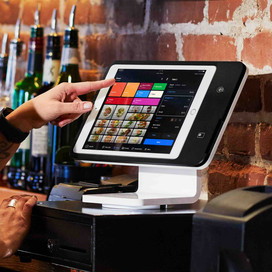Table of contents
Despite recent upticks in staffing, restaurants continue to navigate wavering employment levels, which can cause a snowball effect of challenges. Scarce labor can limit the number of guests your team can serve, and it can put strain on your staff that can lead to burnout and increased turnover. When labor shortages mount, wages tend to rise, and that can cause higher labor costs for your business overall. Restaurant owners are no stranger to challenges, however.
To navigate these hurdles with ease, you can pay close attention to your labor costs and business performance. By using your restaurant technology to understand your labor costs and invest in your staff appropriately, you can work to save both time and money for your restaurant while ensuring a positive atmosphere for your employees.
Knowing your labor cost and labor cost percentage and their significance
Labor costs are one of the most significant line items for a restaurant, accounting for 33 cents of every dollar in sales, according to research from the National Restaurant Association. What contributes to this number? In addition to wages, labor costs encompass everything your business spends towards paying your employees. That includes things like sick days, overtime, bonuses, payroll taxes, and healthcare benefits.
Some labor costs are considered fixed costs, which don’t change over time. Think of salaried employees or hourly employees that work a regular schedule of 30 hours a week as two examples. Other labor costs are variable. Any work that happens on an irregular basis, such as contract workers or cleaning services, can fall within this category. Having a holistic understanding of your labor costs can help you make business decisions that can strengthen your position in the market. High or unsustainable labor costs, for example, can negatively impact your profit margins, which for many restaurants are already razor-thin, falling between 3–5%. Make sure that when you’re calculating your labor costs, you account for both fixed and variable expenses.
With this information, you can determine your labor cost as a percentage of sales or total overhead. To calculate as a percentage of sales, advice from Indeed explains that you’ll first want to determine your restaurant’s total labor cost and your restaurant’s total revenue. Divide the labor cost by the annual revenue and multiply by 100. To calculate as a percentage of total operating costs, first determine your annual labor cost and your total operating costs. Operating costs will include your sales, marketing, overhead costs, and any other expenses. Divide your labor cost by the total overhead costs and multiply by 100 for your labor cost percentage.
What labor cost percentage should your restaurant aim for?
While the ideal restaurant labor cost percentage varies based on the type of establishment you have, most businesses aim for below 30%, according to Indeed.
The labor cost percentage varies among different restaurant types. Quick-service restaurants, where fast service is the main priority, can operate with a lower labor cost, typically around 25%. Casual dining establishments that offer a more relaxed dining experience can aim for up to 30%. Fine dining restaurants, standing out through their high-quality service and gourmet cuisine, might operate within a 35% labor cost percentage.
Setting benchmarks like these can help establish a clear financial goal that aligns with your restaurant’s service style and customer expectations. By comparing the actual labor cost percentage to the target percentage, restaurant owners can quickly identify areas for improvement for success. Understanding these benchmarks and how to calculate them helps in making data-driven decisions to maintain profitability.
Consult labor and sales reports to optimize your restaurant performance.
In changing economic conditions, efficiently reducing restaurant labor costs can be the key to survival and growth for any restaurant business. But before making any changes, it’s important to understand your business metrics and how labor correlates.
You can start investigating your numbers with your restaurant technology. Restaurant owners who use Square Restaurant POS can use the labor versus sales reports to understand sales patterns based on items, category, menu, seating, and time of day. Knowing this information can help you staff appropriately. For instance, if you learn more about when your peak hours are and how much of your staff is working at that time, you can minimize overstaffing, which helps create opportunities for those who are on the floor to earn more in tips.
You can also use this reporting data to identify the best-selling dishes and prioritize these items for upselling opportunities to drive better margins. Set upselling goals for your employees to sell special dishes or high-margin items. With Square Dashboard, you’ll be able to track the results and reward your employees appropriately.
Thoughtfully schedule staff shifts.
Investing in staff training can help enhance your team engagement and productivity, which can ultimately lead to reduced labor costs in your restaurant due to turnover. With a focus on thorough training, you’ll be more likely to retain top talent for your business.
There are a few staffing and training strategies you can use to reduce labor costs in a restaurant. Tools such as Square Team Management help you accurately track your total employee compensation with tip reporting to stay competitive when hiring and ensure you’re not overpaying or underpaying your staff. Your reporting will allow you to track wages by job type and employee to discover multiple roles to upskill their talents and save you money. For example, an employee who works as a server may also want to gain bartending experience, or someone who works as a dishwasher may also be interested in taking on shifts as a busser.
When it comes to reducing restaurant labor costs through management, be sure to schedule employee shifts wisely to reduce overtime whenever possible. With Square Shifts, owners and managers can streamline the scheduling processes, ensuring shifts are optimized and labor costs are controlled.
Use the right food and beverage technology.
Technology can play a pivotal role in enhancing your restaurant’s efficiency and reducing labor costs. Empower your servers with tools like tableside ordering and QR code-based ordering systems. These systems can streamline the ordering process, allowing servers to serve more customers in less time. With quicker table turnovers and reduced order processing time, you’ll be able to drive more sales without the need for additional staff.
By implementing technology that integrates payroll and employee management functions, you save time for even more of your staff. With the Square Team App for Team Members, for instance, you’ll have a centralized platform that simplifies administrative tasks. By automating tasks such as payroll calculations and shift management, managers can use their time to optimize other aspects of the restaurant’s daily operations.
In the food and beverage industry, mastering the art of managing and reducing restaurant labor costs while investing in your team is essential for the sustained success of your business. With Square for Restaurants Plus, everything you need to optimize your labor force and boost your bottom line is at your fingertips. By incorporating insightful reporting, strategic menu optimization, efficient training, and embracing technology solutions, restaurant owners can better navigate the complexities of rising labor and inventory costs.
![]()












